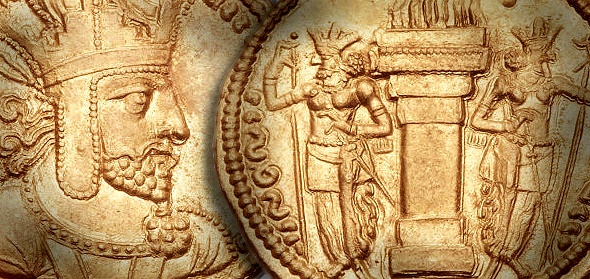
The long and glorious history of Persia as an Imperial power dates to the rise of Cyrus the Great in the sixth century BCE. Cyrus, King of the Parsa people who had settled in the region bounded by the Tigris River and the Persian Gulf, created a vast and enduring empire by subsuming the Median, Lydian and Babylonian Kingdoms and pushing into Thrace and the Indus Valley. At its peak, this Achaemenid or “First Persian Empire” encompassed 8 million square kilometers and ruled over about 44% of the world’s total population, making it by percentages the largest political state in world history.
Though eventually toppled and overrun by Alexander’s Macedonians in the fourth century BC, the native Persian identity remained strong in the successor Seleucid and Parthian Kingdoms. The Parthians were steppe nomads who absorbed the Persian culture thoroughly, including artistic style, modes of dress and religion; their “Empire” was more feudal in nature and less centralized than the Achaemenid Kingdom, but proved resilient enough to defy the growing might and territorial greed of the Romans for nearly three centuries, from 53 BCE to the early 200s CE. However, the Parthians were essentially defensive in their military strategy, content to confine their rule to the Tigris-Euphrates valley and surrounding lands.
All that changed in the 220s, when a new and strong Persian native dynasty arose, the Sasanians (named after the supposed progenitor, Sasan), who defeated their Parthian overlords under the charismatic Ardashir I (224-242). Ardashir declared himself shahanshah, or “king of kings” and set about restoring the reconstituted Persian Empire to the glories and territorial extent it had attained under the Achaemenids six centuries before.
Since much of the former Persian-ruled west, including Asia Minor, Syria, Phoenicia, Judaea and Egypt, were now under Roman control, Ardashir, from the outset of his reign, began attacking the Roman Empire, not just to raid and plunder, as the Parthians had done, but with the intent of detaching and ruling the eastern provinces. Ardashir’s record in this regard was mixed — the Romans were still a force to be reckoned with and counterattacked under the Emperors Severus Alexander (222-235) and Gordian III (238-244), pushing the Persians back to their original frontiers.
Upon Ardashir’s death in 242 and the ascension of his son Shapur I to the throne, the balance of power titled decisively toward the Sasanians. Shapur immediately had to deal with a Roman punitive invasion launched by the boy-emperor Gordian III. Suffering a reverse at Resaena in eastern Asia Minor in 243, Shapur drew the Romans into the Persian desert and defeated them at Misiche, near the capital of Cstesiphon. Gordian was either killed in the battle or deposed and killed by a cabal of his officers; his successor, Philip I “the Arab”, was forced to sue for peace, agreeing to withdraw and pay a large annual subsidy of 500,000 gold aurei. (The gold from this windfall may have provided the source material for the beautiful gold dinar offered in our CICF sale.)
The coin depicts Shapur in full royal regalia, wearing an elaborate crown shaped like a circuit of city walls and surmounted by a korymbos — a great mass of hair gathered in a ball at the top of the head and contained within a decorated cloth sack. His luxuriant hair also spills out behind the crown and over his shoulders — quite evidently Shapur and other Sasanian shahs took great pride in their flowing locks. The reverse depicts two attendants (likely intended to represent Shapur and his father) flanking a Zoroastrian fire altar, pointing to the importance of this dualistic faith to the regime.
For the next eight years, Shapur built his strength up and waited until the Romans were preoccupied with internal civil wars before launching a devastating attack in 253. He captured and sacked Antioch, the third greatest city of the Roman Empire, forcing the newly-installed Emperor Valerian to assemble a large task force and move east to confront the rampant Persians in about 257. Once again, Shapur withdrew before the advancing Romans, drawing them into a perfect trap and capturing Valerian and his entourage alive, the greatest feat of arms yet by a Sasanian monarch and the worst humiliation ever suffered by a Roman emperor.
A famous rock-carved relief in Naqsh-e Rustam shows Shapur seizing Valerian by the arm while another Roman Emperor (Philip?) kneels before him in supplication.
Shapur continued his annual military exploits for the remainder of his reign, becoming the greatest military threat the Romans had faced since the days of Hannibal. His raids and conquests enriched the treasury and enabled him to engage in stupendous building projects; meanwhile, under the relentless pressure the Roman state fragmented and spiraled close to oblivion before starting a recovery in the 270s.
Shapur was more than just a great warrior, however: He employed many of the soldiers, engineers and artisans captured in his campaigns to build and beautify cities throughout his kingdom. A devout and evangelical Zoroastrian, he was nevertheless tolerant of other faiths and is warmly mentioned as a just king in Jewish writings. Upon his death in 270, the Persian Empire was once again arguably the greatest and richest empire on earth.
The Shapur I the Great dinar will be offered as part of Heritage’s April 9 – 14 CICF World Coins & Ancient Coins Signature Auction. For more information and/or to be put on the list to receive a copy of the catalog, contact David S. Michaels ([email protected]) or Sam Spiegel ([email protected]).




